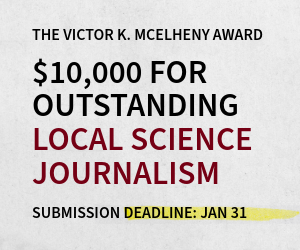On science blogs this week: Dear Abby
NOTHING MARS CURIOSITY'S MARS ADVENTURE. So far, so good. In fact, so far it's been perfect. Our collective seven minutes of terror was vanquished when that nutsy sky crane contraption settled the enormous rover Curiosity — a one-ton nuclear-powered chem lab — down gently exactly where it was supposed to settle down gently. That would be in Mars's Gale crater, where water once flowed.
That the landing was perfection ran against pretty much every expectation except the expectations of the crazy JPL engineers who kept the faith and made it work. Shame on those of us who doubted. Homo sap really is a cool species, at least sometimes.
And here we are, once more watching raptly as Mars photos scoot across 150 million miles of space to land, dazzling, on our monitors. The first 360° color panorama came through yesterday (Thursday). The version of it here is pathetic. You can do much better at Bad Astronomy, where Phil Plait explains how the photo was put together and has posted a version that you can blow up to 3600 x 750 pixels. There are also links to other photos and videos. The comments add to the explication. And to the wonder. From Mark:
...a flying saucer was sent to another planet, and from that saucer emerged a heat-ray wielding, nuclear-powered robot bent on scouring the surface until all knowledge was acquired, and sent back to prepare for invasion and colonization.
For details on the Curiosity chem lab, consult Ashutosh Jogalekar at SciAm's The Curious Wavefunction. For details on the nuclear generator that drives Curiosity — a Mars first — consult Martin Lamonica at Tech Review.
For Curiosity science in the first person, consult Ryan Anderson, a geology postdoc on the science team for Curiosity's ChemCam instrument. Here's the archive of his own Martian Chronicles, which he's been writing for the American Geophysical Union's Blogosphere.
At Sandwalk, Larry Moran points out that science aboard Curiosity is about lots more than just the search for signs that microbes could have lived there. He would like science writers to keep that in mind:
For scientists, the best is yet to come. I hope the science journalists can keep the public focused on the real mission and the importance of the data.
DEAR ABBY, I NEED SOME BLOGGING ADVICE. The case of Diabetes Warrior v. the State of North Carolina has, it seems to me, pretty big implications for the free speech of bloggers, and I'm a little surprised they're not raising more hell about it.
In brief: Steve Cooksey, former diabetic, reports achieving normal blood sugar with exercise and the paleo diet — heavy on meat, plant foods (except grains), and some fats, but no sugar and damn few carbs. His blog Diabetes Warrior is hugely popular, which upset the North Carolina Board of Dietetics/Nutrition. It used a state law to force Cooksey to stop rendering counsel on eating and to display a disclaimer on his site.
Cooksey succumbed to the state's authority, made the changes, and then filed a Federal suit claiming violation of his First-Amendment rights. The libertarian Institute for Justice, which is backing him, claims that forcing Cooksey to be a licensed dietician would be like forcing Dear Abby to become a licensed psychologist, according to an unsigned item at the HuffPo.
Cooksey also set up a life-coaching business to sell his advice. Selling services is maybe borderline, but sounding off and offering advice on a blog is what bloggers do. Using the power of the state to prescribe (and proscribe) bloggery is an alarming abrogation of free speech — not least because it's an attempt to preserve the commercial hegemony of mainstream dietiticans.
DEAR ABBY: WHICH IS THE REAL PALEO DIET? Meanwhile, SciAm guest blogger Rob Dunn says we've got the paleo diet all wrong. Or, rather, just which paleo diet should we be eating? The one from 12 thousand years ago? 100 thousand years ago? 40 million years ago? Dunn argues that it's not the imagined Stone Age diet of meat meat meat that evolution has adapted us for. Our real ancestral diet is what our monkey and ape kin eat: fruits, nuts, leaves, plus bugs and very occasional meat, for example an unusually slow lizard or bird. Our brains and immune systems, Dunn says, have evolved to be very different from theirs, but our guts are similar. He concedes there may be important evolutionary changes — for example, in our gut microbes — but he votes to stick with mostly eating plants. Still, any paleo diets, insects and all,
are better than the average modern diet, one so bad that any point in the past can come to seem like the good ole days, unless you go too far back to a point when our ancestors lived more like rats and probably ate everything, including their own feces.
DEAR ABBY: HOW COME SLIM PEOPLE GET DIABETES? Obesity is probably the best-known risk factor for Type 2 diabetes, now routinely called an epidemic. Which is why "the obesity paradox" is what they're calling research showing that diabetes can be a far more dangerous disease in people of normal weight than it is for fatties. In the latest long-term study, just published in JAMA, normal-weight diabetics were twice as likely to die — and 30% to 50% more likely to die of cardiovascular disease.
According to Anahad O'Connor at Well, this turns out to be true for other chronic disorders too: heart failure, hypertension and kidney disease. The reason is a mystery, although there are, of course, some theories. Maybe docs nag their fat patients more than the thinner ones? Or treat them more aggressively? Or maybe some study subjects were actually terminally ill and wasting away, hence classified as of normal weight?
The latest diabetes study got around this last methodological difficulty by using weight at diagnosis. And its researchers theorize that the apparent paradox may relate to belly fat, since it is possible to weigh in normally even though apple-shaped. From Howard LeWine at the Harvard Health Blog:
In the JAMA study, the researchers found that people who were overweight or slightly obese but who had reasonable waist sizes (and therefore not too much belly fat) had better prognoses. In contrast, normal-weight people with large waists had the highest risk of premature death.
DEAR ABBY: IS OBESITY GOOD FOR JOB GROWTH AND THE ECONOMY? Talk about the Obesity Paradox does not, of course, mean that obesity is not a health problem, and many stand ready to fight it. Take, for example, Bank of America Merrill Lynch, which wants us to view obesity as a business opportunity and a time to buy stocks. As recounted by Marion Nestle at the Health Care Blog, the recommended stocks fall into four areas: pharmas/health care (obesity drugs, diabetes, joint replacements, disability equipment and accoutrements, etc.), health food and related products, nutrition management, and sports apparel and equipment. This last category, the company says,
is the longer-term play, but we believe that promoting physical activity will become a key priority for more government health policies.
One example: Laura Newman, SciAm guest blogger, describes how pharmas are promoting insulin analogues for treatment of diabetes, especially in developing countries, although there is no clear evidence they are superior to insulin itself. They are, of course, much more expensive.
BOGGLE YOUR MIND. I'm traveling for the next few weeks and don't know how often I'll be posting. Meantime, spend one of the best 1.5 minutes of your life floating through this largest-ever 3D map of the universe, courtesy of the Sloane Digital Sky Survey. As 80beats recommends, do click on full screen, the bigger the better.






